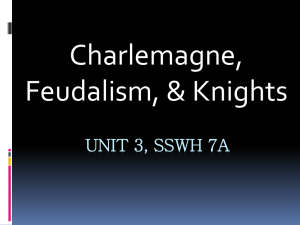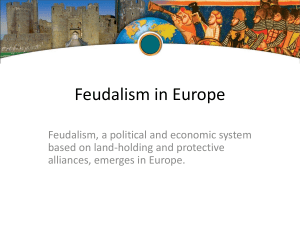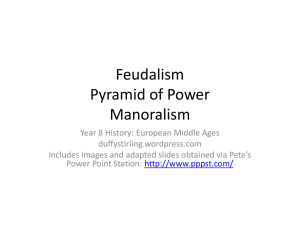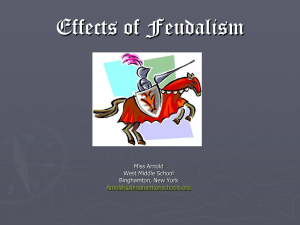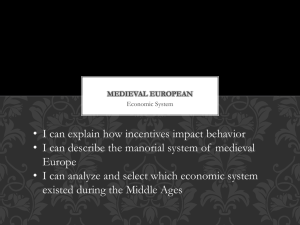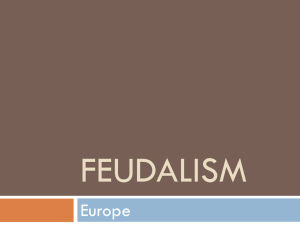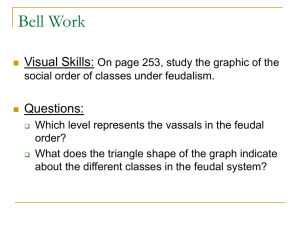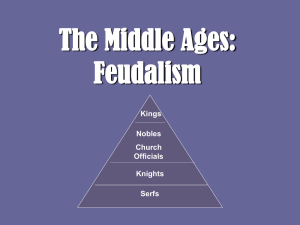ECON-220 HISTORY OF ECONOMIC THOUGHT
advertisement
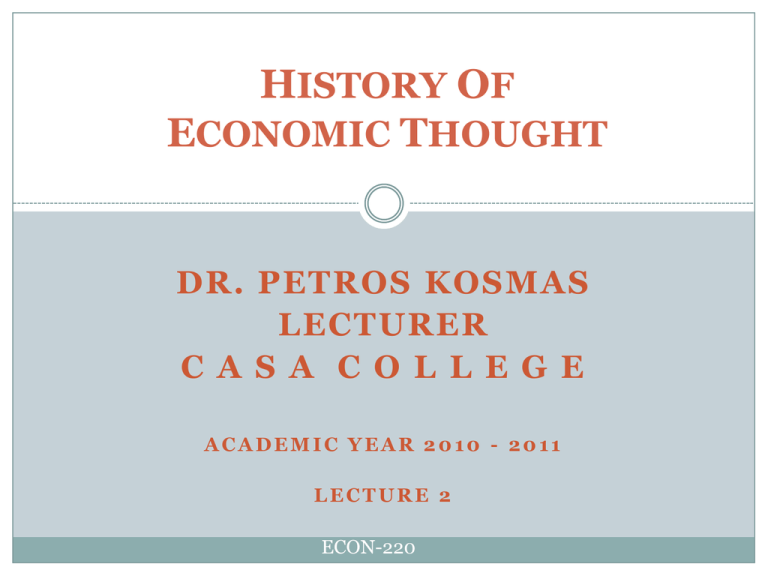
HISTORY OF ECONOMIC THOUGHT DR. PETROS KOSMAS LECTURER C A S A C O L L E G E ACADEMIC YEAR 2010 - 2011 LECTURE 2 ECON-220 Early Pre-Classical Economic Thought: Ancient Times Chanakya’s Arthashastra. Hediod’s Works and Days (Poem). Xenophon’s Oeconomicus. Plato’s Republic. Aristotle’s Politics. ECON-220 Early Pre-Classical Economic Thought in the Middle Age: Thomas Aquinas (1225-1274) He was an Italian theologian and writer on economic issues. He dealt with the concept of a just price, which he considered necessary for the reproduction of the social order. A just price was supposed to be one just sufficient to cover the costs of production, including the maintenance of a worker and his family. He argued it was immoral for sellers to raise their products simply because buyers were in pressing need for a product. ECON-220 Early Pre-Classical Economic Thought in the Middle Age: Thomas Aquinas (1225-1274) Aquinas discusses a number of topics in the format of questions and replies, substantial tracts dealing with Aristotle’s theory. Two of his questions concern economic issues, mainly relate to what a just price is, and to the fairness of a seller dispensing faulty goods. He argued against any form of cheating and recommended compensation always be paid in lieu of good service. In his opinion human laws might not impose sanctions for unfair dealing, divine law did, in his opinion. ECON-220 Thomas Aquinas: Human Nature and the Common Good and the Necessity of Government Tyranny should be avoided by the appropriate selection of kings and construction of institutions. A ruler must temper his bodily or sexual powers with his or her rational faculties. The good ruler rarely overpowers his subjects but channels their activities for the common good. ECON-220 Thomas Aquinas: Tyranny and Tyrannicide A tyrant seeks to impose his or her own private interests by force as opposed the legitimate political leader who seeks peace, moral enhancement, and sufficient distribution of material goods. The tyrant is guilty of sedition from Aquinas’ perspective. Resistance to the injustice of the tyrant must be proportional to that injustice. Public authorities should remove a tyrant but appeal to divine intervention could be an alternative if this option is not available. ECON-220 Early Pre-Classical Economic Thought in the Middle Age: Duns Scotus (1265-1308) One of Aquinas’ main critics in his work Sententiae (1295). He thought it possible to be more precise than Aquinas in calculating a just price, emphasizing the costs of labour and expenses. Because buyer and seller usually have different ideas of what price comprises. If people did not benefit from a transaction, in Scotus’ view, they would not trade. He defended merchants as performing a necessary and useful social role, transporting goods and making them available to the public. ECON-220 Feudalism Aim: How did feudalism restructure the society, government, and economy of European countries? Do Now: What is feudalism? What was life like for the peasants? The socioeconomic system that preceded Capitalism in Western Europe. Development of Feudalism From 800-1000 Vikings invaded Western Europe constantly which meant they would loot, steal, and kill if necessary. ECON-220 CONSTRUCTING THE PYRAMID OF THE SOCIAL CLASSES IN THE PERIOD OF FEUDALISM ECON-220 CONSTRUCTING THE PYRAMID OF THE SOCIAL CLASSES IN THE PERIOD OF FEUDALISM SERFS AND FREEMEN 90% of the population ECON-220 CONSTRUCTING THE PYRAMID OF THE SOCIAL CLASSES IN THE PERIOD OF FEUDALISM LESSER NOBLES (KNIGHTS) LABOR PROTECTION SERFS AND FREEMEN 90% of the population ECON-220 CONSTRUCTING THE PYRAMID OF THE SOCIAL CLASSES IN THE PERIOD OF FEUDALISM POWERFUL NOBLES OR LORDS LAND AND PROTECTION LOYALTY AND MILITARY SERVICE LESSER NOBLES (KNIGHTS) LABOR PROTECTION SERFS AND FREEMEN 90% of the population ECON-220 CONSTRUCTING THE PYRAMID OF THE SOCIAL CLASSES IN THE PERIOD OF FEUDALISM KING LOYALTY AND SERVICE LAND POWERFUL NOBLES LAND AND PROTECTION LOYALTY AND MILITARY SERVICE LESSER NOBLES (KNIGHTS) LABOR PROTECTION SERFS AND FREEMEN 90% of the population ECON-220 Feudalism: An exchange system Political, social, and economic system that worked on the basis of exchange between kings, nobles, knights, and peasants. Kings gave land to nobles in exchange for money and nobles allowed peasants to work this land in exchange for protection. Kings give land, nobles give protection, peasants give labor. ECON-220 Feudal Exchanges The Lord’s estate or the land he was given by the King, was known as a Manor. Peasants worked / farmed all day long from sun up until sun down without breaks in order to pay taxes and survive. Serfs were taxed for everything! Taxes were used to protect the peasants… (Church Tax, Marriage Tax, Crops). ECON-220 Manorialism Manors had churches, mills, farms, and homes for the peasants who were bound to the manor. The economic system or style of economy that existed on the manors of Europe. It stressed selfsufficiency. The serfs/peasants on a manor rely on one another. The manor becomes self-sufficient: able to function without outsider help. ECON-220 Workers on the Manor There were two groups of peasant workers on the manor: Freemen- skilled workers who paid rent and could leave the manor whenever they wished. (They usually had a skill needed by others on the manor.) Serfs – workers bound to the land by contract with the nobles. (They had no freedom - they where the noble’s property.) ECON-220 What is a Knight? Almost all nobles were knights. Training began at age 7, as a page, under the guidance of the lady of the manor. Became squires at age 15 and were trained by other knights. Those deemed worthy were “dubbed” knights. ECON-220 Relationship Between Lords and Vassals The relationship between lords and vassals made up a big part of the political and social structure of the feudal system. Vassals had certain duties to perform for the lord. All nobles were ultimately vassals of the king. ECON-220 Feudal Contract LORDS GIVE SERVICE TO GIVE PROTECTION TO VASSALS ECON-220 The growth of feudalism in Europe during the Middle Ages was primarily caused by the 1. rivalry between the colonial empires. 2. suppression of internationalism. 3. decline of the Roman Catholic Church. 4. collapse of a strong central government. ECON-220 Knowledge Check… Why did the Kings give land to the Nobles? What did the Nobles do for the Peasants? How did the Peasants repay the Nobles? How does Feudalism work? ECON-220 REVIEW 1) Everyone owed loyalty to the ________ 2) _______ were really the most powerful. They got _______ from the king. 3) Lesser nobles (knights) gave _________ _________ in return for land 4) _______ were bound to the land. They worked in return for ____________. 5) __________ were skilled workers. They paid rent to the ______ and were free to move if they wanted to. ECON-220 REVIEW 1) Everyone owed loyalty to the king. 2) Nobles were really the most powerful. They got land from the king. 3) Lesser nobles (knights) gave military service in return for land. 4) Serfs were bound to the land. They worked in return for protection. 5) Freemen were skilled workers. They paid rent to the nobles and were free to move if they wanted to. ECON-220 Feudalism influenced Europe by: providing social stability. fostering the growth of religion. eliminating warfare. encouraging formal education ECON-220 The traditional villages of India peasants were seldom able to change their social status. women dominated the political decisions of the local councils. people could choose from a number of different occupations. monarchs exerted absolute power over local governments. ECON-220 Feudalism in Japan Japan’s social hierarchy was similar but they did not have knights, they had Samurai. The Way of the Warrior: Strict code of Samurai conduct and loyalty until death. Bushido The Way of the Warrior: Strict code of Samurai conduct and loyalty until death. ECON-220 Exit Slips Why did people begin living on manors? Why did they accept feudalism? How did feudalism change the political, social, and economic way of life in Europe? ECON-220
